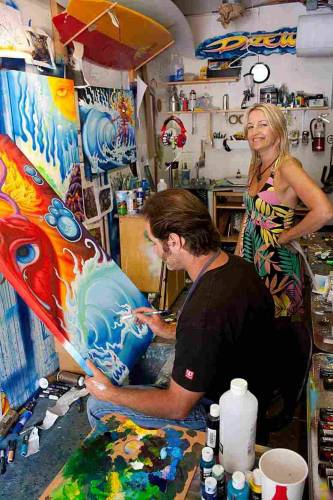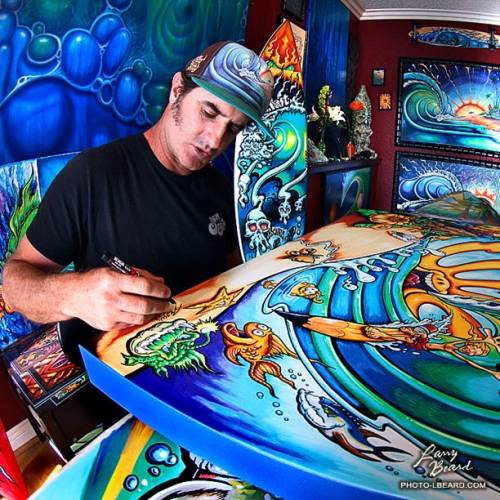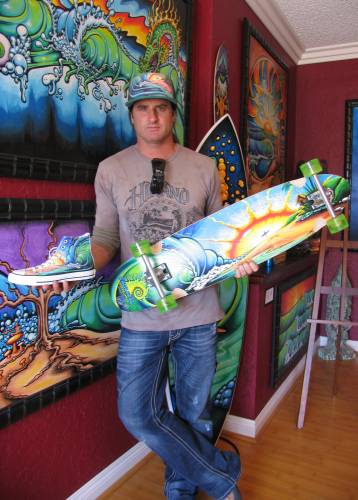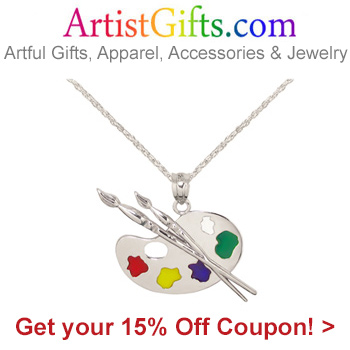Artsy Shark interviews art licensing expert Maria Brophy on how artists can protect themselves when negotiating art licensing contracts.

Maria Brophy and husband surf artist Drew Brophy in the studio. His work is extensively licensed. Photo Credit: David Macomber
AS: What has changed in the licensing world in the past few years?
MB: Wow, so much has changed in just a few years! When the economy crashed in 2008, licensing took a big hit. Many retailers went out of business, and the effect trickled down to the licensors and artists.
My husband and I felt the pinch of that directly. It was early 2008 when we had developed a line of Drew Brophy boys clothing for the 175 store chain called Mervyns. We were very excited and expected nice, fat royalty checks! But then, in December of 2008, Mervyns went out of business and closed all of their stores.
These days, buyers are very careful about what they will place in their stores. It used to be that retailers would see something they liked, and even if it was a new artist or a new brand, they would give it a try.
Now, they play it safe and stick with what’s proven. This doesn’t leave much room for innovation or creativity, when the buyers are afraid to try something new!
AS: How are artists losing out on licensing contracts?
MB: There can be many red flags in contracts that artists miss. The biggest problem I see, over and over again, is an artist getting trapped in an exclusive contract that isn’t earning them any money.
One artist that I consulted with had signed a five year contract for all of her art, for all products in the world. (Never do that, please!) It was an exclusive, so she wasn’t able to license or sell her art anywhere else. This created a serious income problem for her, because two years into the contract the licensee still hadn’t paid her a dime! Essentially, she wasn’t able to make money from her business, because of signing this terrible contract.
An easy fix to that contract, in the beginning before signing, would have been for her to ask the licensee to include termination language that allowed her to terminate the contract should it not earn her a certain amount in royalties. That way, after a year of not earning money, she could have cancelled it and moved on.
Another remedy would have been to choose only some images to be a part of the contract, and only for the specific products that the manufacturer is producing.
The happy ending to this artist’s problem is that we were able to work with the licensee and get them to let her out of the contract. She got lucky. And she vowed to never sign such a deal again!

Maria Brophy and husband surf artist Drew Brophy in the studio. His work is extensively licensed. Photo Credit: David Macomber
AS: Do artists need an attorney to create a licensing contract?
MB: It’s not always necessary. For many deals, a simple contract will work. But, for artists who are ready to fully invest in an art licensing career, it is prudent to hire an attorney to draw up an agreement that can be used over and over again, and then hire that attorney to spend time explaining every part of the contract so you understand it. The cost can range from $500 to $1,500.
For many simple or straightforward deals, you can get by without an attorney; you can use standard art licensing contract language. Just make sure that your contract is artist-friendly and includes protections for the artist, such as a way to terminate should the contract not earn enough money, copyright protections and a limit on what rights the licensee is being granted.
AS: What results do you see artists getting when they use smart contract strategies?
MB: Many artists don’t realize that the contract they sign is a direct reflection of their own business strategy and long term vision for their art.
The artists’ vision should dictate what they will agree to and what they will say “no” to. The contract language that follows is a written agreement of the understanding and deal that was made with the licensee.
For example, an artist who creates “fine art” and sells to upscale galleries might have a vision for their art that includes licensing for top quality products sold in fine department stores. In this case, the contract would allow the licensee to sell only top quality products to upper-tier department stores, such as Saks or Nordstrom, but not Wal-Mart.
A different example would be an artist who focuses entirely on creating art for the mass market. They might want their products in Wal-Mart, because that’s their target market and it fits their business strategy to sell high volume of lower cost items. In this case, the contract would reflect those wishes.
The worst thing an artist can do is sign a contract that would put their art on products or for sale in places that would hurt their business plan or strategy, or in the case of a fine artist, their relationship with existing collectors.
Unfortunately, many artists will agree to things they don’t want to do, either because they feel pressured, or because they don’t realize what they are signing on for.
It’s important to say “no” to the things that are not right for you or your art, so that you have room to say “yes” to things that are!
AS: How can the the licensing contract templates you developed help artists?
MB: I have consulted with numerous artists who needed a template for licensing contracts. So I created a package that is easy to understand and can be used over and over again. I use this contract myself for a majority of Drew Brophy deals.
It has a simple art licensing template with instructions on how to use the template and how to close a deal from start to finish. There’s also a template for a “Deal Memo” and an “Amendment” to the contract, both items that will come in handy for every artist.
This package is great for:
- Artists who want to be sure that they are protected in a licensing deal
- Artists who aren’t ready to invest in having an attorney draw up a contract, and need something easy and ready-to-go
- One-time payment license deals
- Royalty deals
- Illustration packages
- T-shirt designs, Sticker Designs, most deals in which you want to license your art for a temporary use
I don’t recommend using this package, however, for everything. There are times when you should get legal counsel. Here’s a few examples:
- Deals where there is a large sum of money involved;
- Complicated deals that require a long form contract, and
- Any deal involving licensing rights outside of product manufacturing, including TV shows, live media, or book publishing (these deals have their own specific concerns and standards; you should work with an attorney who specializes in that area).
If someone is interested but not sure if this package will help, they are welcome to email me at Consulting(at)MariaBrophy.com and I’ll be happy to let you know if I think it will be a solution to your situation.
AS: Do you have any closing thoughts on licensing contracts?
MB: Though we tend to focus on things that can go wrong in business, I want to stress that there are many great companies out there that care about the artist and that are willing to sign a fair contract.
Artists should always ask for what they want in a contract. I have found that most companies are willing to work with you and to make the changes you ask for.
Often we look at negotiating as a contest, but I see it differently; negotiating is simply a conversation between two parties where they try to understand each other’s needs and come to a mutual agreement based on meeting those needs. The best deals are the ones where everyone wins!




Great interview and insight, but I’ve come to expect nothing less from Maria. I’m curious about the fate of the designs created for Mervyns. It wouldn’t surprise me if Maria and Drew still own the rights. Where they ever placed or licensed in another deal with some one else ?
Marty
Marty, thanks for the kind words! To answer your question:
The copyrights of Drew’s designs for Mervyn’s are indeed owned by Drew Brophy. And yes, some of that art has since been licensed out for other products for kids, such as boogie boards and skimboards.
Thanks for reading!
Hello,
I am an artist, but also Exec Director of the National Delphic Council USA, part of the International Delphic Council. It is sort of an Olympics for the Arts. I am looking into Industry standards for the licensing and rights as it could apply to the game participant’s artwork that is specifically made for the Games. the IDC has its ideas and I am most interested in protecting our artists while insuring all parties are treated fairly.
The games occur every four years for the adults (26+) and every four years for the Jr. games, at two year intervals. The arts included have a wide range, so in this instance , we will deal strictly in visual arts. We are a non-profit (501-c-3). just getting started in the US.
I would appreciate your thoughts on such an endeavor. I am glad to have read the article.
Thank you for your time.
Michelle, It’s nice to hear that you want to keep the best interests of the artists in mind while putting your program together.
There are many different ways to do this; but I think what would benefit both the artists and the organization is to create a license agreement where the artist retains all copyrights, but grants limited rights to the organization for a period of time (the # of years in which you will use the art), and that there is a % split between the artist and the organization for any revenues collected from that license arrangement.
When the end result is advantageous to the artist, you will get an artists’ best work, along with their enthusiasm!
Maria, your article is spot on as usual, I always enjoy reading your articles and learning from your experiences. Your contract package is very good and I hope many artists will do themselves a favor and use it in their licensing deals ~ Alex
Alex, thank you for the kind words! So glad to know that it is helpful to you. 🙂
Maria, Great interview. Thanks for the insights. I’ve got a question for you: Do you represent other artists for a living as well? It sounds like you’ve got a great handle on the process. Am an artist of many years myself and am looking to see what markets there are that I can tap into. Thanks again for the insights. Free advice in the world of business is always welcome. Artists aren’t always the savviest in that regard and tend to fail for that reason. – Jezli
Jezli, thanks! To answer your question – I used to represent other artists, but I found that it was a business model that didn’t work with my lifestyle, so after a few years I decided to focus entirely on repping my husband. That’s how I ended up consulting artists – many of my artist friends needed help with some of the things that Drew and I had figured out. So now my mission is to help artists to learn how to do a lot of these things themselves.
As far as artists not being savvy in business; this is true in general, but, I find that most of the artists that I have worked with are incredibly intelligent and fully capable of being business savvy. The thing that holds them back is that they lack the confidence in that part of them, and the other thing is that they would rather be painting then dealing with contracts! (Who can blame them?!)
As a surfer shaper an artist, Drew and Maria are a part of my inspiration to start painting in 2001 along with Michael Brindley an Rick Delanty. I have worked with Maria and Drew and I have found how important it is to have a positive perspective on every situation and ride the choppy waves that make oneself grow forward and always paddle back out for another ride. Keep up the good work and thanks for the support.
Paul, thanks for the kind words! It’s been a joy to watch you grow as an artist over the past decade. Your positive energy has had a great impact on me, too. Thanks!
Hello Maria!
Thanks for your courage to be honest and share your knowledge, your experience. Good for you…:)!
I am thrilled to read about your vision, passions and integrity.
Love all the information, but I am finding myself, still lost. Where can I obtain the Artist Short Licensed Agreement Package?
I need direction and info..
thanks again Maria
Cheers,
Tina Marie
I am a macro floral photographer…pls. check out my work.
http://tina-marie.artistwebsites.com/
[img]http://tina-marie.artistwebsites.com/[/img]
Tina,
You can obtain the Artist Short Licensed Agreement Package here http://www.artsyshark.com/LicensingContractTemplates
Tina, thanks for reading this interview. We all feel lost at times, but after looking at your website, I see you have accomplished so much! Your work is wonderful, and you are making it available online. Congratulate yourself on your achievements, feel good about what you have done, and continue moving forward at the same time. This business of art is not one that brings success overnight; it takes commitment and long term focus. I can see that you are doing both, so trust that you are moving in the right direction!
Hello, I read the article and it’s was very helpful. I’m starting out as an artists full time. I was always intimidated about how to get some exposure. I’ve shared this my readers on my blog also. Can’t keep this to myself you know.
Great article! I will be sure to save it for future reference. I found it at the perfect time, as I will be diving into the art licensing world by the end of this year. Thank you for sharing your knowledge, and I look forward to reading more~
I have been selling my art for a little while now, but none of it has been copyrighted. I have been approached on several occasions to license my artwork but feel I need to copyright it first. Can I copyright a collection of numerous designs all together for one fee or do they have to be done individually? I would love a reply if possible. Thanks.
Dear Eva,
It is best to copyright your work before you license it, however, it is not required.
I recommend that all artists get in the habit of regularly copyrighting their art as they create it; monthly or quarterly is a good practice.
For my husband’s art, since he creates over a hundred new pieces a year, we now copyright it monthly. For all pieces he created in the month of September, for example, we filed as a group on one copyright application, on October 1st.
But, for someone who has never filed their copyrights, my advice is to get started, anywhere! Start with one filing, and get used to the process online at http://www.copyright.gov. The first one is always the hardest!
Dear Maria, As a long time artist, inexperienced with contracts etc. I am facing a decision about how to market my coloring book projects. I really need to generate income and have little time or money for the marketing end. The first is a child/adult coloring book about What Kind Of Star AM I, the second, for high school onto adult are abstract drawings selected out of about 30 years of pen and ink drawing. I don’t want to be foolish .I’ve seen friends taken and don’t want to be one of those. At my age its difficult to generate capitol and I do not have peers who can help with group funding such as video adds for foundations that require you look sharp and have lots of give always in place. I’m from the generation that said do good work and the rest will fall into place. Now it seems the marketing almost comes first. Any suggestions for a mature artist with little revenue for funding her projects? Thanks for your articles. I’m really enjoying them. Maridee
Dear Maria
Are you familiar with websites like Houzz? I have an opportunity with a similar Platform to sell my work. I am so confused by one part of the contract as follows, “You retain all rights in all content. You grant (not going to say the companies name) Parties a perpetual, non-exclusive, royalty-free, worldwide, and fully sub-licensable (through multiple tiers) right to use, reproduce, perform, distribute,display, adapt, modify and create derivative works of the Content, in order to offer your Products for sale on the platform and in advertising and promotional material related to the Platform, to allow other Platform users to include the content in “inspiration Boards” or in connection with other features of the Platform, to improve the Platform, and develop new products, services, features, and functionalities, in each case, without additional compensation”. I spoke with the company and they said this was nothing to be concerned about they wouldn’t do anything without my consent and that the files I would be uploading would not be of print quality anyway. That this is from their legal department and are just covering all their bases. I am trying to do the same. As a graphic artist the files are the work, small files or not. I hope you can give me some insight on this or perhaps point me in the right direction for the answer. By signing the agreement am I giving away IP? What does it mean in plain English. Thank you.